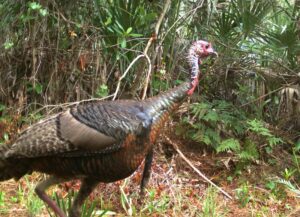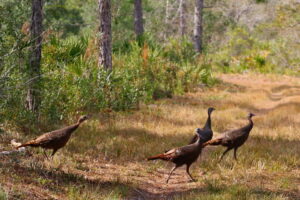 The Osceola Turkey: Majestic Beauty of the Florida Wilds
The Osceola Turkey: Majestic Beauty of the Florida Wilds
The Osceola Turkey: Majestic Beauty of the Florida Wilds
The Osceola Turkey, scientifically known as Meleagris gallopavo osceola, is a captivating and distinct subspecies of wild turkey found exclusively in the state of Florida. Renowned for its striking appearance and elusive nature, the Osceola Turkey holds a special place in the hearts of hunters, conservationists, and nature enthusiasts alike. In this article, we will explore the habitat, eating and mating habits, as well as the distinguishing features that set the Osceola Turkey apart from its counterparts.

- Distribution and Habitat: The Osceola Turkey’s range is limited to the peninsula of Florida, making it an endemic species to the region. Its distribution extends from the northern areas of the state, such as Nassau and Duval counties, all the way south to the Everglades and Big Cypress Swamp. This confined range has led to the evolution of unique characteristics specific to the Osceola Turkey.
- Preferred Habitat: Within its limited range, the Osceola Turkey favors a diverse array of habitats. These include cypress swamps, pine flatwoods, hardwood hammocks, and oak-dominated scrublands. The dense cover provided by these habitats serves as protection against predators while offering abundant food sources. The Osceola Turkey’s adaptability to various environments within Florida showcases its resilience and ability to thrive in different ecosystems.
- Feeding Habits: Like other wild turkeys, the Osceola Turkey is an omnivore with a diverse diet. Its feeding habits vary based on the availability of food sources throughout the year. In the spring and summer, the turkey forages for insects, spiders, frogs, and lizards, which provide essential protein during the breeding season. During fall and winter, its diet shifts to include seeds, acorns, berries, and other plant matter. The Osceola Turkey’s ability to adapt its diet to changing seasons contributes to its survival and reproductive success.
- Mating Behavior: The mating behavior of the Osceola Turkey is a captivating display of courtship and natural selection. Breeding typically occurs between February and April, during the spring season. Male Osceola Turkeys, known as toms or gobblers, exhibit elaborate courtship rituals to attract females, known as hens. These displays involve puffing out feathers, fanning tail feathers, strutting, and producing distinctive gobbling sounds. The dominant tom in an area often wins the opportunity to mate with multiple hens. This competition ensures that only the strongest and fittest individuals pass on their genes, enhancing the population’s overall genetic quality.
- Differences from Regular Wild Turkeys: The Osceola Turkey possesses several distinct features that set it apart from regular wild turkey subspecies. Firstly, it displays unique feather coloration, characterized by rich, dark plumage with a metallic green or bronze sheen. The white bars on its tail feathers contrast vividly against the dark background, creating a stunning visual display. Additionally, the Osceola Turkey tends to be slightly smaller in size compared to other subspecies, with males averaging around 18-20 pounds and females weighing between 8-10 pounds. These subtle differences contribute to the Osceola Turkey’s individuality and make it a sought-after game species among hunters.
The Osceola Turkey, with its limited distribution and remarkable characteristics, represents the natural beauty and diversity of the Florida wilds. Its preference for specific habitats, adaptable feeding habits, and unique mating behavior contribute to its overall ecological significance. Preserving and conserving the Osceola Turkey’s habitat is crucial to ensuring the survival of this remarkable subspecies.
Here are 20 distinct features of the Osceola Turkey, along with an expanded explanation of each point:

- Endemic to Florida: The Osceola Turkey is found exclusively in the state of Florida, making it an endemic subspecies to the region. Its limited range adds to its uniqueness and desirability among hunters.
- Feather Coloration: The Osceola Turkey boasts striking feather coloration. Its plumage is predominantly dark with a metallic green or bronze sheen. This distinct coloration adds to its aesthetic appeal.
- White Bars on Tail Feathers: The tail feathers of the Osceola Turkey display distinct white bars that contrast against the dark background, creating a visually captivating pattern.
- Subspecies Size: On average, male Osceola Turkeys weigh around 18-20 pounds, while females weigh between 8-10 pounds. This slightly smaller size compared to other subspecies is a notable characteristic.
- Specific Habitat Preference: The Osceola Turkey thrives in a range of habitats within Florida, including cypress swamps, pine flatwoods, hardwood hammocks, and oak-dominated scrublands. Its habitat preference contributes to its distinct ecological niche.
- Adaptability: Despite its specific habitat preference, the Osceola Turkey has demonstrated adaptability to different environments within its limited range, showcasing its ability to thrive in varying ecosystems.
- Elusive Nature: Osceola Turkeys are known for their elusive behavior, often making them a challenging target for hunters. Their wariness and evasive tendencies add to the thrill of pursuing them.
- Courtship Displays: During the mating season, male Osceola Turkeys engage in elaborate courtship displays to attract females. These displays involve puffing out feathers, fanning tail feathers, strutting, and producing distinctive gobbling sounds.
- Gobbling Sounds: The gobbling sounds produced by male Osceola Turkeys are unique and can be heard from a considerable distance. This vocalization is an essential part of their mating behavior and communication.
- Multiple Hens: Dominant toms often have the opportunity to mate with multiple hens. This competitive mating behavior ensures the selection of the fittest individuals and contributes to the overall genetic quality of the population.
- Omnivorous Diet: Osceola Turkeys have an omnivorous diet, feeding on a variety of food sources throughout the year. Their diet includes insects, spiders, frogs, lizards, seeds, acorns, berries, and other plant matter.
- Foraging Patterns: The foraging patterns of Osceola Turkeys vary based on seasonal food availability. They adapt their feeding habits to ensure a balanced diet and sufficient nutrition for survival and reproduction.
- Roosting Habits: Osceola Turkeys roost in trees at night, seeking safety and protection from predators. They often choose mature trees with dense foliage to conceal themselves while they sleep.
- Flying Ability: Osceola Turkeys are strong and agile flyers. Their ability to fly allows them to escape danger, find suitable roosting sites, and explore new areas in search of food and mates.
- Sharp Eyesight: Turkeys, including the Osceola Turkey, have excellent eyesight. They can detect even the slightest movements, making them highly wary and challenging to approach undetected.
- Camouflage Adaptations: The Osceola Turkey has evolved natural camouflage adaptations, such as mottled feathers and patterns that blend with their habitat. These adaptations provide them with enhanced camouflage and protection from predators.
- Social Behavior: Osceola Turkeys exhibit social behavior, often gathering in small flocks or groups outside the breeding season. These flocks provide safety, better foraging opportunities, and social interaction.
- Nesting Habits: Hens build nests on the ground, often hidden in dense vegetation or near the base of trees. They carefully select nest sites that provide shelter and concealment for their eggs.
- Incubation and Nest Defense: Female Osceola Turkeys incubate their eggs for approximately 28 days, during which they diligently defend their nests against potential threats. The female’s commitment to nest defense ensures the survival of their offspring.
- Conservation Status: The Osceola Turkey, like other wild turkey subspecies, is managed and conserved to maintain healthy populations. Conservation efforts focus on habitat protection, sustainable hunting practices, and population monitoring to ensure their long-term survival.
These 20 distinct features collectively contribute to the allure and fascination surrounding the Osceola Turkey, making it a cherished species within the realm of hunting, wildlife observation, and conservation.
Leave a Reply